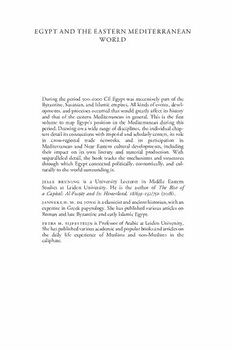
Egypt and the Eastern Mediterranean World: From Constantinople to Baghdad, 500-1000 CE PDF
Preview Egypt and the Eastern Mediterranean World: From Constantinople to Baghdad, 500-1000 CE
EGYPT AND THE EASTERN MEDITERRANEAN WORLD During the period 500–1000 CE Egypt was successively part of the Byzantine,Sasanian,andIslamicempires.Allkindsofevents,devel- opments,andprocessesoccurredthatwouldgreatlyaffectitshistory and that of the eastern Mediterranean in general. This is the first volume to map Egypt’s position in the Mediterranean during this period.Drawingonawiderangeofdisciplines,theindividualchap- tersdetailitsconnectionswithimperialandscholarlycenters,itsrole in cross-regional trade networks, and its participation in Mediterranean and Near Eastern cultural developments, including their impact on its own literary and material production. With unparalleled detail, the book tracks the mechanisms and structures through which Egypt connected politically, economically, and cul- turallytotheworldsurroundingit. jelle bruning is a University Lecturer in Middle Eastern Studies at Leiden University. He is the author of The Rise of a Capital: Al-Fustāt and Its Hinterland, 18/639–132/750 (2018). ˙ ˙ jannekeh.m.dejongisaclassicistandancienthistorian,withan expertiseinGreekpapyrology.Shehaspublishedvariousarticleson RomanandlateByzantineandearlyIslamicEgypt. petra m. sijpesteijn isProfessorofArabicatLeidenUniversity. Shehaspublishedvariousacademicandpopularbooksandarticleson the daily life experience of Muslims and non-Muslims in the caliphate. EGYPT AND THE EASTERN MEDITERRANEAN WORLD 500–1000 From Constantinople to Baghdad, CE edited by JELLE BRUNING JANNEKE H. M. DE JONG PETRA M. SIJPESTEIJN UniversityPrintingHouse,Cambridgecb28bs,UnitedKingdom OneLibertyPlaza,20thFloor,NewYork,ny10006,USA 477WilliamstownRoad,PortMelbourne,vic3207,Australia 314–321,3rdFloor,Plot3,SplendorForum,JasolaDistrictCentre, NewDelhi–110025,India 103PenangRoad,#05–06/07,VisioncrestCommercial,Singapore238467 CambridgeUniversityPressispartoftheUniversityofCambridge. ItfurtherstheUniversity’smissionbydisseminatingknowledgeinthepursuitof education,learning,andresearchatthehighestinternationallevelsofexcellence. www.cambridge.org Informationonthistitle:www.cambridge.org/9781009170017 doi:10.1017/9781009170031 ©CambridgeUniversityPress2022 Thispublicationisincopyright.Subjecttostatutoryexception andtotheprovisionsofrelevantcollectivelicensingagreements, noreproductionofanypartmaytakeplacewithoutthewritten permissionofCambridgeUniversityPress. Firstpublished2022 AcataloguerecordforthispublicationisavailablefromtheBritishLibrary. isbn978-1-009-17001-7Hardback CambridgeUniversityPresshasnoresponsibilityforthepersistenceoraccuracyof URLsforexternalorthird-partyinternetwebsitesreferredtointhispublication anddoesnotguaranteethatanycontentonsuchwebsitesis,orwillremain, accurateorappropriate. Contents ListofFigures,Graphs,andTables pagevii NotesonContributors ix NotesonTransliteration,Names,andDates xiii PrefaceandAcknowledgments xiv MapofLateAntiqueandEarlyIslamicEgypt xvi Introduction 1 JelleBruning,JannekeH.M.deJong,andPetraM.Sijpesteijn part i political and administrative connections 17 1 EgyptintheAgeofJustinian:ConnectororDisconnector? 19 PeterSarris 2 AttheCrossroadsofRegionalSettings:Egypt,500–1000CE 46 YaacovLev 3 TheFrontierZoneattheFirstCataractbeforeandattheTime oftheMuslimConquest(FifthtoSeventhCenturies) 73 StefanieSchmidt 4 IslamicHistoriographyonEarlyMuslimRelationswithNubia 103 SylvieDenoix 5 LocalTraditionandImperialLegalPolicyundertheUmayyads: TheEvolutionoftheEarlyEgyptianSchoolofLaw 131 MathieuTillier 6 IbnTūlūn’sPacificationCampaign:Sedition,Authority, ˙ andEmpireinAbbasidEgypt 169 MatthewS.Gordon v vi Contents part ii economic connections 203 7 BetweenRamlaandFustāt:ArchaeologicalEvidence ˙ ˙ forEgyptianContactswithEarlyIslamicPalestine (Eighth–EleventhCenturies) 205 GideonAvni 8 Egypt’sConnectionsintheEarlyCaliphate:Political, Economic,andCultural 238 PetraM.Sijpesteijn 9 TradingActivitiesintheEasternMediterraneanthrough CeramicsbetweenLateAntiquityandFatimidTimes (Seventh–Tenth/EleventhCenturies) 272 JoanitaVroom part iii social and cultural connections 323 10 TheDestructionofAlexandria:ReligiousImageryandLocal IdentityinEarlyIslamicEgypt 325 JelleBruning 11 ScribalNetworks,Taxation,andtheRoleofCoptic inMarwanidEgypt 353 JenniferCromwell 12 AChangingPositionofGreek?GreekPapyri intheDocumentaryCultureofEarlyIslamicEgypt 379 JannekeH.M.deJong 13 RegionalDiversityintheUseofAdministrativeLoanwords inEarlyIslamicArabicDocumentarySources(632–800CE): APreliminarySurvey 408 EugenioGarosi 14 Babylon/Qasral-Shamʿ:ContinuityandChangeattheHeart ˙ oftheNewMetropolisofFustāt 446 ˙ ˙ PeterSheehanandAlisonL.Gascoigne 15 UtilizingNon-MuslimLiterarySourcesfortheStudy ofEgypt,500–1000CE 465 MagedS.A.Mikhail Index 493 Figures, Graphs, and Tables Figures 3.1 MapofAswānwithareasexcavatedbytheSwiss–Egyptian mission. page75 3.2 Planofarea2withtownwallandRomancityquarter. 77 5.1 TransmissionofknowledgeamongEgyptianfuqahāʾ. 136 9.1 MapofEgyptwiththemostimportantproductionzones oflateantique–earlyIslamicceramics. 274 9.2 ShapesofLateRomanAmphora7(LRA7)fromEgypt. 277 9.3 LRA7fragmentsfromEgyptandpiechartshowing thetotalamountofamphorae,foundinthecityofLimyra, southwesternTurkey. 281 9.4 DistributionmapofLRA7fromEgypt. 282 9.5 Shapesofbag-shapedamphoraefromEgypt. 284 9.6 DistributionmapofimportedamphoraetoBeirutinlate antiquity. 288 9.7 Distributionmapofbag-shapedamphoraefromEgypt. 289 9.8 MenasflaskfromRMO,Leiden;distributionmap ofMenasflasksinFrance. 290 9.9 ShapesofEgyptianRedSlipWareA,B,andC. 293 9.10 Distributionandshapesofvariouspaintedwares intheeasternMediterranean. 295 9.11 IstablʿAntar/Fustāt:shapesofamphoraefromanUmayyad ˙ ˙ ˙ context,incombinationwithimagesofastampedamphora stopperandaglasssealwithArabicinscriptionreferring toal-Qāsim. 297 9.12 IstablʿAntar/Fustāt:shapesofAbbasidglazedandpainted ˙ ˙ ˙ tablewares. 299 vii viii ListofFigures,Graphs,andTables 9.13 IstablʿAntar/Fustāt:shapesofAbbasidglazedandpainted ˙ ˙ ˙ tablewares,includingabowlwithapaintedKufic calligraphicmotifingreenandbrown. 302 9.14 IstablʿAntar/Fustāt:shapesofFatimidglazedandpainted ˙ ˙ ˙ “FayyumWare”bowlsanddishes. 304 9.15 DistributionmapofimportedIslamictablewares onByzantinesitesintheeasternMediterranean. 306 9.16 DistributionmapofvariouswaresexportedfromEgypt. 309 14.1 PlanshowingtherealsizeandlayoutoftheRoman fortressofBabylonanditsrelationshiptotheMosque ofʿAmrb.al-ʿĀs. 451 ˙ Graphs 5.1 Geographicaloriginofmasters. 140 5.2 Geographicaloriginofstudents. 141 5.3 NumberofindividualmasterswhotransmittedtoEgyptian jurists. 141 12.1 Globallydatedpapyri. 401 12.2 Datedpapyripertwentyyears. 401 12.3 Provenanceoftextsdated640–700. 403 Tables 5.1 ListofEgyptianfuqahāʾwhodiedbefore200/816. 154 5.2 Foreignfuqahāʾdeadbefore200/816whovisitedEgypt orsettledthere. 165 9.1 FindslistofimportedIslamictablewaresonByzantinesites intheeasternMediterranean. 307 12.1 NumbersofdatedtextsintheHGVpercentury, 500–800CE. 402 12.2 NumbersofdatedtextsintheHGVpertwentyyears. 402 12.3 Overviewofthearchivesfromtheseventhcentury. 403 Notes on Contributors gideon avni is Chief Archaeologist for the Israel Antiquities Authority and Professor of Archaeology at the Hebrew University in Jerusalem. His academic interests focus on various aspects of classical, late antique, early Islamic, and medieval archaeology, cultural and religious transformations, the diffusion of technologies and movement of people in the Near East and beyond. His recent books are The Byzantine–Islamic Transition in Palestine: An Archaeological Approach (2014), and A New Old City: Jerusalem in the Late Roman Period (2017). jelle bruning is a University Lecturer in Middle Eastern Studies at Leiden University and a historian of early Islamic Egypt. He has a particular interest in the social history of slavery and (un)freedom under the Umayyads and Abbasids and in literary descriptions of Egypt’s religious landscape, especially Islamic images of Alexandria. He is the author of The Rise of a Capital: Al-Fustāt and Its Hinterland, ˙ ˙ 18/639–132/750(2018). jennifer cromwell is Senior Lecturer in Ancient History at Manchester Metropolitan University, having previously held research positions in Oxford, Sydney, and Copenhagen. Her research interests focusinparticularonthesocialandeconomichistoryoflateantiqueand early Islamic Egypt, including the role played by Coptic after the conquest.Sheistheauthor ofRecordingVillageLife: ACopticScribein EarlyIslamicEgypt(2017). johanna h. m. (janneke) de jong is a teacher of Classics and an independent scholar, having previously been employed as Assistant Professor in Roman History (Utrecht University, Radboud University Nijmegen) and as postdoc researcher in Greek papyrology (Leiden University). Her research interests focus on the political and social ix x NotesonContributors history of Egypt in the Greek millennium (ca. 330 BCE–800 CE), in particularonrelationsofpowerandconstructionsofidentities. sylvie denoix isaFrenchhistorianofthemedievalArabicworld.Sheis currently Senior Researcher at the Centre National de la Recherche Scientifique(CNRS).UsingbothmedievalArabicchroniclesandarch- ivalmaterialsuchaswaqfs,shehascarriedoutseveralstudiesintourban history, either by studying a particular city such as Fustāt (seventh– ˙ ˙ fifteenth centuries) or Cairo (Mamluk period), or by thinking about urbantypologiesinthemedievalMuslimworld.Shehasalsoworkedon specificissuessuchastherelevanceofworkingontopicssuchasprivate propertyandpublicdomaininthemedievalArabworld.Sheiscurrently working on how the Arab historians reported on Muslim conquests in aframeoftherhetoricofwarandpeaceinmedievalArabictexts. eugenio garosi is a postdoctoral researcher in the research group on Arabic Papyrology at the Ludwig Maximilian University. His research focusesonthesocialhistoryoftheearlyIslamicEmpire,Arabicpapyr- ologyanddiplomatics,anddiglossiainpre-modernIslamicatesocieties. His publications include Projecting a New Empire: Formats, Social Meaning, and Mediality of Imperial Arabic in the Umayyad and Early AbbasidPeriods(2022). alisonl.gascoigneholdsanAssociateProfessorshipinArchaeologyat the University of Southampton, having gained her PhD at the University of Cambridge. Her research interests lie mainly in Egypt, withparticularfocusonthearchaeologyofurbanismfromlateantiquity tothelatemedievalperiod.Shehasco-directedaprogramoffieldwork atthe importantsiteof Tell TinnisinLakeManzala, published asThe IslandCityofTinnis:APostmortem(2020).Shehasalsopublishedonthe archaeologyofOld Cairo/Fustāt,Hisnal-Bāb(Aswān),andtheNorth ˙ ˙ ˙ ˙ Kharga Oasis in Egypt, as well as the sites of Jam and the Bala Hissar (Kabul)inAfghanistan. matthew s. gordon teachesIslamicandMiddleEastHistoryatMiami University (Oxford, Ohio). His first monograph was The Breaking of a Thousand Swords (2001).He has co-editedConcubinesand Courtesans: WomenandSlaveryinIslamicHistory(2017)andistheco-editor/translator ofTheWorksofIbnWādihal-Yaʿqubī:AnEnglishTranslation(2018).He ˙ ˙ has completed a biography of the Egyptian governor Ahmad b. Tūlūn ˙ ˙ (2021),andhasbegun,withMathieuTillier(UniversitéParis-Sorbonne), atranslationofal-Kindī’schronicleofthegovernorsofEgypt.
